Madeleine Lucas
[/et_pb_text][et_pb_text _builder_version=”3.23.3″ text_font=”Standard2||||||||” custom_margin=”|70px||”]Major: Earth and Planetary Sciences
Madeleine Lucas is a senior majoring in Earth and Planetary Sciences conducting conducting cave research with Dr. Mitchell Barklage of the Earth and Planetary Sciences Department. Lucas is also a member of Northwestern’s varsity soccer team and is involved with Geoclub on campus.
[/et_pb_text][/et_pb_column][et_pb_column type=”3_5″ _builder_version=”3.23.3″][et_pb_image src=”https://thenurj.com/wp-content/uploads/2019/12/MammothCave-01.png” _builder_version=”3.23.3″][/et_pb_image][et_pb_text _builder_version=”3.23.3″ text_font=”Standard2|600|||||||” text_font_size=”25px”]Summary
[/et_pb_text][et_pb_text _builder_version=”3.23.3″ text_font=”Times New Roman||||||||” text_font_size=”19px” text_line_height=”1.5em”]What we know about the Mammoth Cave system stems from the 833 km of explored cave, but it is hypothesized that this represents only half of the total cave system. Many caves passages within this complex system are extremely hard and, in some cases, impossible to physically access. The independent water source feeding the Echo River Accessory Spring can be classified as one of these “impossible” caves to access. Mammoth Cave scientists have attempted to use a variety of different methods, such as dye-tracing, scuba diving, and even remotely operated vehicles, to access this water-filled cave passage, with no success. Difficulty in locating the water-filled cave passage feeding the Echo River Accessory Spring suggests that another approach is necessary. Electrical resistivity tomography allows us to model and “explore” caves tens of meters below the Earth’s surface without stepping foot inside. Using this technique, we imaged low-resistivity anomalies interpreted to be water-filled cave passages, which likely supply the Echo River Accessory Spring water. This result characterizes a previously undiscovered Mammoth Cave passage and could potentially extend the known extent of the total cave system. These findings will ultimately open up the possibility for further scientific advancements regarding the cave. We also anticipate that this result will allow for a better understanding of how water flows through the Mammoth Cave system and out through springs into the Green River, while also demonstrating the utility of ERT in subsurface karst terrain exploration.
[/et_pb_text][/et_pb_column][/et_pb_row][/et_pb_section]

Leave a Comment